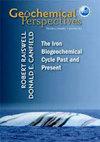Metallogeny and Mineral Exploration – Some Personal Reminiscences
IF 6.8
3区 地球科学
Q1 GEOCHEMISTRY & GEOPHYSICS
引用次数: 0
Abstract
The following personalised narrative aims to document the highlights of my involvement in some of the ground breaking developments in Economic Geology and their direct application to mineral exploration and discovery over the past half century. The story begins with my introduction to geology at secondary school and university, followed by doctoral research based on fieldwork in the Andes of South America. Then, as an employee of the Chilean Geological Survey, I got my introduction to porphyry copper deposits before returning to the UK to take up a post-doctoral research fellowship. This formative period concluded with my starting out as an independent geological consultant to the global exploration and mining industry. These early years happened to coincide with the plate tectonics revolution and its radical implications for metallogeny. I realised that porphyry copper and related deposits are integral parts of volcano-plutonic arcs generated during subduction of oceanic lithosphere, and volcanogenic massive sulphide deposits in ophiolite complexes must have formed at oceanic spreading centres. At approximately the same time, application of K-Ar dating to copper deposits led to definition of metallogenic belts and corresponding epochs in the Andes, and then established the timing of their economically important supergene oxidation and enrichment. Subsequently, using more modern and precise U-Pb zircon and Re-Os molybdenite methods, collaborative attempts were made to determine porphyry copper deposit lifespans and ages of various copper belts, deposits and prospects around the world, including the Zambian Copperbelt. The focus on porphyry copper deposits led first to an appreciation of the linkage between them and subaerial volcanism and the importance of potassic alteration as a major host of hypogene copper mineralisation, and then to geological characterisation of the increasing number of gold-rich examples. Appreciation of the importance of hydrothermal breccias in porphyry copper deposits, including recognition of mineralised diatremes, resulted in a classification scheme for breccias that may be extended to related deposit types. Extensive fieldwork showed that zones of advanced argillic alteration, termed lithocaps, constitute the shallow parts of porphyry copper systems. The role of tectonic uplift in both porphyry copper formation and subsequent supergene modification was also charted. The end result of this body of work was a porphyry copper model that can be used as a basic exploration guide. In response to a marked increase in the world gold price in the late 1970s, more effort was devoted to gold concentrations in magmatic arc terranes, commencing with epithermal gold deposits in the shallow lithocaps of porphyry copper systems. This led to an input to classification schemes for epithermal precious metal deposits and, eventually, to assignment of the three main epithermal types to specific tectono-magmatic settings. After years of speculation, porphyry gold deposits were recognised for the first time in northern Chile, followed by definition of a new gold deposit class in association with relatively reduced granitic intrusions. A magmatic-hydrothermal origin for Carlin-type gold deposits was steadfastly supported over many years, notwithstanding its unpopularity until relatively recently, culminating in a proposal for modern analogues. For decades, metallogenic provinces and corresponding epochs have been widely appreciated, but debate concerning their origin(s) persists. The nature of accompanying magmatism could well provide an adequate explanation for at least some provinces (e.g., tin, molybdenum and possibly silver), but precursor metal enrichment in the lowermost crust and/or subcontinental lithospheric mantle may well be required in the case of gold and copper provinces. The story concludes with brief commentary on mineral exploration, which has been my lifelong (pre)occupation. Requirements for success in mineral exploration are discussed, based primarily on familiarity with the circum-Pacific region, followed by analysis of the types of companies and individuals involved and the burgeoning challenges to the exploration process, which, if not remedied, will have dire consequences for future metal production and global plans for the energy transition. My involvement as a lone practitioner in both mineral exploration and metallogenic research probably says something about my independent character traits, but nonetheless has been largely unstructured and certainly unplanned. I have no hesitation in recommending a similar career path for any recent graduate who relishes adventure and is prepared to endure significant work-life imbalance.金属成因与矿物勘探--一些个人回忆
以下个人叙述旨在记录我在过去半个世纪中参与经济地质学的一些突破性发展及其在矿产勘探和发现中的直接应用的重点。故事从我在中学和大学学习地质学开始,然后是在南美洲安第斯山脉进行实地考察的博士研究。之后,作为智利地质调查局的一名雇员,我开始接触斑岩铜矿床,然后回到英国从事博士后研究工作。在这段成长期结束后,我开始担任全球勘探和采矿业的独立地质顾问。早年恰逢板块构造革命及其对金属成因的重大影响。我意识到斑岩铜及相关矿床是大洋岩石圈俯冲过程中产生的火山-板块构造弧的组成部分,而蛇绿岩复合体中的火山成因块状硫化物矿床一定是在大洋扩张中心形成的。大约在同一时期,通过对铜矿床进行 K-Ar 测定,确定了安第斯山脉的金属成矿带和相应的时代,进而确定了具有重要经济意义的超生氧化和富集的时间。随后,利用更现代、更精确的 U-Pb 锆石和 Re-Os 辉钼矿方法,合作尝试确定斑岩型铜矿床的寿命和包括赞比亚铜带在内的世界各地各种铜带、矿床和矿区的年龄。对斑岩型铜矿床的关注首先使人们认识到斑岩型铜矿床与次生火山活动之间的联系,以及钾盐蚀变作为次生铜矿化主要宿主的重要性,然后对越来越多的富金矿床进行了地质特征描述。我们认识到热液角砾岩在斑岩铜矿床中的重要性,包括对矿化双岩的认识,并由此制定了角砾岩分类计划,该计划可扩展到相关矿床类型。广泛的实地考察表明,斑岩铜矿系统的浅部构成了被称为 "岩帽 "的高级镁质蚀变带。此外,还描绘了构造抬升在斑岩铜形成和随后的超生改造中的作用。这项工作的最终成果是建立了一个斑岩铜模型,可作为基本勘探指南。20 世纪 70 年代末,随着世界金价的显著上涨,人们对岩浆弧地层中的金富集问题投入了更多的精力,首先是斑岩铜系统浅层岩帽中的表生金矿床。这导致了对热液贵金属矿床分类计划的投入,并最终将三种主要热液类型归入特定的构造-岩浆环境。经过多年的推测,斑岩型金矿床首次在智利北部得到确认,随后又定义了与相对减少的花岗岩侵入体有关的新的金矿床类别。卡林型金矿床的岩浆-热液成因多年来一直得到坚定的支持,尽管直到最近这种观点还不受欢迎,但最终提出了现代类似的观点。几十年来,成矿带和相应的时代一直受到广泛重视,但有关其起源的争论却一直存在。至少某些矿带(如锡、钼和可能的银)的伴生岩浆活动的性质可以提供充分的解释,但对于金矿带和铜矿带,可能需要在最下部地壳和/或次大陆岩石圈地幔中富集前体金属。故事最后简要评述了矿产勘探,这是我毕生的(前)职业。文章主要基于对环太平洋地区的熟悉,讨论了矿产勘探成功的要求,随后分析了参与勘探的公司和个人类型,以及勘探过程中不断涌现的挑战,这些挑战如果得不到解决,将对未来的金属生产和全球能源转型计划造成严重后果。我独自一人参与矿产勘探和成矿研究,这或许说明了我独立的性格特征,但在很大程度上是无序的,当然也是无计划的。我毫不犹豫地向任何喜欢冒险并准备忍受工作与生活严重失衡的应届毕业生推荐类似的职业道路。
本文章由计算机程序翻译,如有差异,请以英文原文为准。
求助全文
约1分钟内获得全文
求助全文
来源期刊

Geochemical Perspectives
GEOCHEMISTRY & GEOPHYSICS-
CiteScore
0.80
自引率
0.00%
发文量
1
期刊介绍:
Each issue of Geochemical Perspectives presents a single article with an in-depth view on the past, present and future of a field of geochemistry, seen through the eyes of a highly respected member of our community. The articles combine science and history of the field’s development and the scientist’s opinions about future directions. We expect personal glimpses into the author’s scientific life, how ideas were generated, pitfalls and triumphs along the way, and how ideas were adopted to carry our field further. Perspectives articles are intended for the entire geochemical community, not for experts. They are not reviews or monographs or text books. They go beyond the current state of the art, providing opinions about future directions and impact in the field.
 求助内容:
求助内容: 应助结果提醒方式:
应助结果提醒方式:


